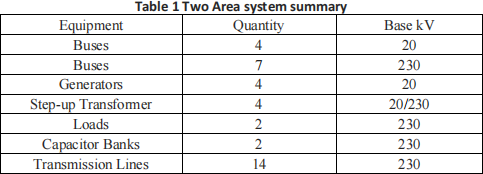ELEC7310, MODULE I: POWER SYSTEM STABILITY AND DYNAMICS (SECURITY)
Assignment #1: Power-Flow and Short-Circuit Studies
Instructor: Prof. Mithulan Nadarajah
Submission Date: March 15, 2024

Figure 1: A single-line diagram of two-area test system.
Questions:
1. Power Flow Calculation:
a. Use the data given in Appendix-I to build the Two-Area test system as depicted in Figure 1 in the Power factory or PSS\E. The system summary is shown in Table 1.
b. Run a power flow calculation using Newton-Raphson Method and present the results voltage profile (magnitude and angle), Generators real and reactive power, lines and transformers loading.
c. With (GEN G1) as the reference machine repeat part (b) and comment on the results.
d. With the base case as in part (a) turn off the shunt capacitance on Bus 9 and repeat (b) and comment on the results.
e. Repeat part (d) Decoupled Power Flow Method. Briefly explain and compare power flow calculation methods in parts (d) and (e).

2. Short Circuit Current Calculation:
a. Apply a balanced short circuit (3-pahse fault) at all the buses and report the short circuit power level of each bus in a bar graph.
b. Increase the shunt capacitance at bus 7 from 200 to 400 MVAr and repeat (a) and comment on the results.
c. With the base case as in part (a), modify the transmission lines parameters (R, X & B) by multiplying their values by factor of 0.5 and 1.5, in two cases. Repeat (a) and compare the new short circuit power level of each bus with your findings from part (a). Comment on the results.
d. With the base case as in part (a), reduce all the generators MVA rating by 20%. Repeat (a) and compare the new short circuit power level of each bus with your findings from part (a). Comment on the results.
e. Briefly explain the factors that influence the system short circuit level and what are the solutions to improve the short circuit level of the system.
3. Appendix:
